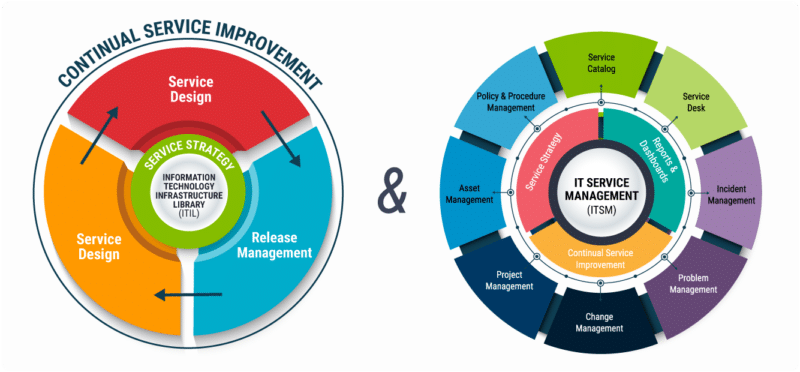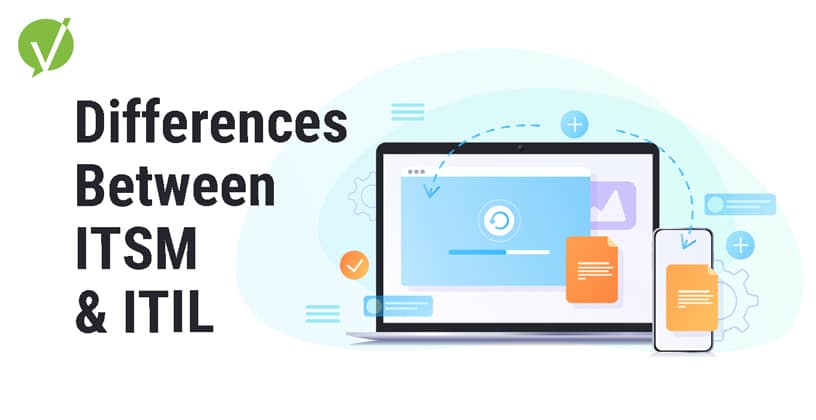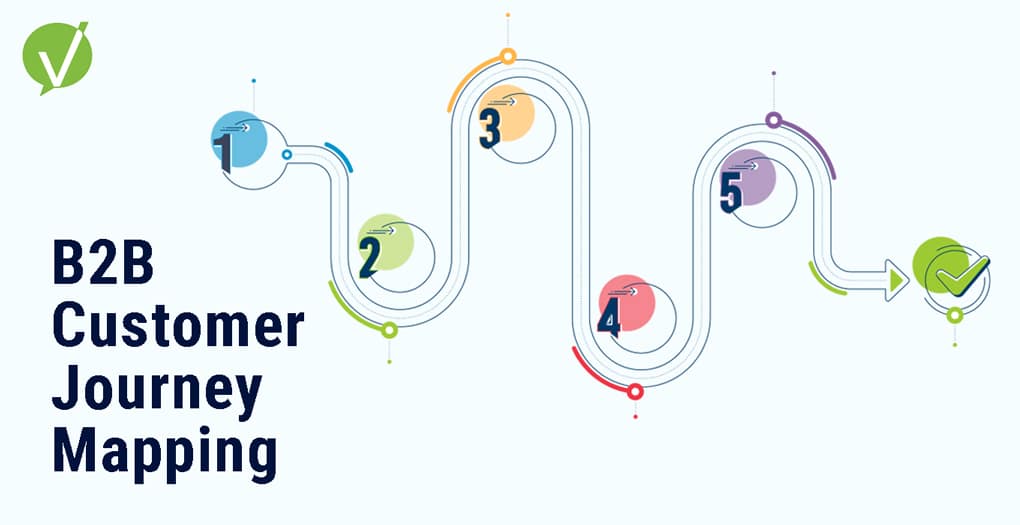What Is The Difference Between ITSM and ITIL?
Introduction
When it comes to IT service management, two terms that often get thrown around are ITSM and ITIL. While the two are interconnected, there are significant differences between them that can impact your organization’s efficiency and effectiveness.
ITSM stands for IT service management, which is an overarching approach that seeks to manage IT services in a way that meets business needs. This includes everything from incident management to change management to problem management. On the other hand, ITIL, which stands for the Information Technology Infrastructure Library, is a framework for implementing best practices in IT service management. ITIL is a framework that consists of a set of processes for delivering and supporting IT services, with the ultimate goal of aligning IT services with business needs.
Understanding the differences between ITSM and ITIL is crucial, as they form the foundation of best practices for effective IT service management. This article will explore how these frameworks can be synergistically utilized to enhance the management and efficiency of your organization’s IT services.
Key Takeaways:
- ITSM and ITIL are both critical concepts in effective IT service management.
- ITSM is an overarching approach, while ITIL is a specific framework for implementing best practices.
- ITIL is a set of processes for delivering and supporting IT services, with the ultimate goal of aligning IT services with business needs.
- By understanding their differences, you can better leverage ITSM tools and ITIL best practices to increase efficiency and deliver quality services.
The key takeaway is to remember that ITSM software sets the stage, and ITIL provides the roadmap for implementing best practices in IT service management.

What is the ITSM Framework?
Information Technology Service Management (ITSM) is a framework that enables organizations to manage and deliver IT services in an efficient and effective manner. At its core, ITSM is about aligning IT services with the needs of the business and ensuring that they are delivered in a way that meets the highest standards of quality.
The ITSM framework comprises a set of best practices for managing IT services, including incident management, problem management, change management, and service level management. These processes are designed to facilitate better communication, collaboration, and end-to-end service delivery across the IT organization.
Core Components of ITSM |
Benefits of ITSM Best Practices |
|---|---|
|
|
Adopting ITSM best practices can help organizations to optimize their IT services, reduce costs, and improve overall business outcomes. Whether you are managing a complex IT infrastructure or simply need to provide top-quality IT services to your customers, ITSM project management can provide you with the tools and resources to succeed.
ITSM Framework Applied
- Service Downtime: The business frequently experiences network outages and server downtimes, causing disruptions in operations and affecting employee productivity.
- Slow Response Times: Employees often complain about slow response times when they request IT support, leading to frustration and delays in issue resolution.
- Inefficient Resource Allocation: The IT department struggles with allocating resources effectively, leading to underutilized hardware and overworked staff in some areas while others remain under-resourced.
This is where ITSM comes into play:
- Alignment with Business Needs: By implementing ITSM practices, the business can ensure that its IT department can adopt ITSM frameworks like ITIL (Information Technology Infrastructure Library) to improve service quality, reduce downtime, and enhance the overall user experience.
- Streamlined Incident Management: ITSM provides incident management processes that help the IT department respond more efficiently to service disruptions. This reduces response times and minimizes the impact of technical issues on the business.
- Resource Optimization: ITSM tools and practices can help the IT department optimize resource allocation. For example, by implementing a service catalog, the business can allocate resources based on the criticality of each service, ensuring that the most important services receive adequate support.
In summary, ITSM helps businesses address everyday IT challenges by aligning IT services with business needs, maintaining high-quality standards, streamlining incident management, and optimizing resource allocation. By adopting ITSM principles, businesses can enhance their overall operational efficiency and ensure that their IT services meet the highest standards of quality and reliability.
What is the ITIL Framework?
If you’re looking for a globally recognized framework for IT service management, ITIL is the answer. ITIL stands for Information Technology Infrastructure Library, and it comprises a set of best practices that help organizations deliver value-added IT services to their customers.
The ITIL framework was developed by the UK government’s Central Computer and Telecommunications Agency (CCTA) in the 1980s. At the time, the IT industry lacked a standardized framework for IT service management, which was becoming increasingly critical as the industry grew in complexity. ITIL provided a systematic and structured approach to IT service management.
Today, ITIL is owned and maintained by Axelos, a joint venture between the UK government and Capita, a private company. The framework has evolved over the years, with the latest version being ITIL 4, which was launched in 2019.
ITIL Framework Applied
- Service Disruptions: The business frequently experiences disruptions, such an application crashes or network failures, which impact critical operations and customer services.
- Inefficient Change Management: Implementing changes to IT systems, whether it’s deploying new software or updating hardware, often results in unintended consequences and disruptions.
- Lack of Documentation: There is a lack of comprehensive documentation regarding IT services and processes, making it difficult for IT staff to troubleshoot issues and maintain consistency.
- Poor Communication: Communication between different IT teams is often fragmented, leading to misalignment of goals and inefficient collaboration.
Here’s how the ITIL framework can help address these challenges:
- Incident Management: ITIL emphasizes effective incident management processes, allowing the IT department to respond promptly to service disruptions. By implementing ITIL incident management practices, the business can reduce downtime and minimize the impact of incidents on critical operations and customer services.
- Change Management: ITIL provides a structured approach to change management, ensuring that changes are thoroughly planned, tested, and documented. This reduces the risk of disruptions caused by changes and enhances the stability of IT services.
- Service Catalog: The ITIL framework encourages the creation of a service catalog that provides detailed information about available IT services. This catalog helps IT staff and end-users understand what services are available, their features, and how to request them.
- Communication and Collaboration: ITIL promotes improved communication and collaboration among IT teams through practices like the Service Integration and Management (SIAM) approach. By fostering better communication, teams can work together more effectively to address challenges and achieve common objectives.
In summary, the ITIL framework enables businesses to tackle everyday IT challenges by providing structured processes for incident management, change management, and documentation. It also encourages better communication and collaboration among IT teams. By adopting ITIL principles, businesses can enhance the reliability and efficiency of their IT services, leading to improved overall business operations.
ITIL Best Practices For Service Management
The ITIL framework comprises a set of best practices that organizations can adopt to improve the delivery of IT services. These best practices cover the entire IT service lifecycle, from service strategy to service design, transition, operation, and continual service improvement.
Some of the key ITIL best practices include:
- Service Level Management – defining, agreeing, monitoring, and reporting on the level of service required and delivered.
- Incident Management – restoring normal service operations as quickly as possible and minimizing the impact on business operations.
- Problem Management – identifying and resolving the root cause of incidents to prevent them from recurring.
- Change Management – managing the lifecycle of all changes to IT infrastructure and services.
ITIL Certification
ITIL certification is a validation of an individual’s knowledge of the ITIL framework. It is offered by Axelos
through accredited training organizations worldwide. There are several levels of ITIL certification, including Foundation, Practitioner, Intermediate, Expert, and Master.
ITIL certification can provide individuals with a competitive advantage in the job market, as it demonstrates their proficiency in IT service management best practices.
If you’re looking to improve your organization’s IT service management practices or your own IT service management skills, ITIL certification is an excellent place to start.
Difference between ITIL and ITSM
Let’s recap what distinguishes ITSM vs. ITI? While both frameworks aim to improve IT service management, they differ in the scope of their objectives and practices.
Objectives
ITSM, as the name suggests, focuses on managing IT services in an efficient and effective manner. It provides a holistic approach, covering all aspects of IT services, from design to operations to improvement.
ITIL, on the other hand, offers a specific set of best practices for IT service management. Its objective is to align IT services with the needs of the business and improve service quality, while also delivering value to the customers.
Implement ITSM
The core of ITSM is the ITSM processes. These include Incident Management, Problem Management, Change Management, Service Level Management, and many others. These processes enable IT teams to meet organizational objectives by providing them with detailed guidance on how to manage IT services efficiently and effectively.
ITIL, on the other hand, is known for its ITIL processes. These include Service Strategy, Service Design, Service Transition, Service Operation, and Continual Service Improvement. The ITIL processes provide IT teams with a specific set of procedures and best practices for service management, governance, and operational excellence.
ITIL vs. ITSM
While ITSM encompasses a wide range of practices, ITIL is a specific set of best practices for IT service management. ITSM is a broader concept that provides a holistic approach to IT services, while ITIL is a more specific framework that offers guidance on how to achieve best practices in IT service management.
Overall, ITSM and ITIL are complementary frameworks that can be used together for effective IT service management. While ITSM provides a comprehensive approach, ITIL offers specific sets of best practices for achieving success.
ITSM and ITIL: Critical Components
Ready to unlock the full potential of IT service management for your organization? By combining the comprehensive approach of ITSM with the specific best practices of ITIL, you can supercharge your IT service management efforts. Whether you’re a newcomer or a seasoned pro, harness the power of these frameworks to boost productivity, enhance customer satisfaction, and drive success in today’s digital landscape. To discover how Vivantio can elevate your IT service management game, reach out to our team today or sign up for a free demo.









